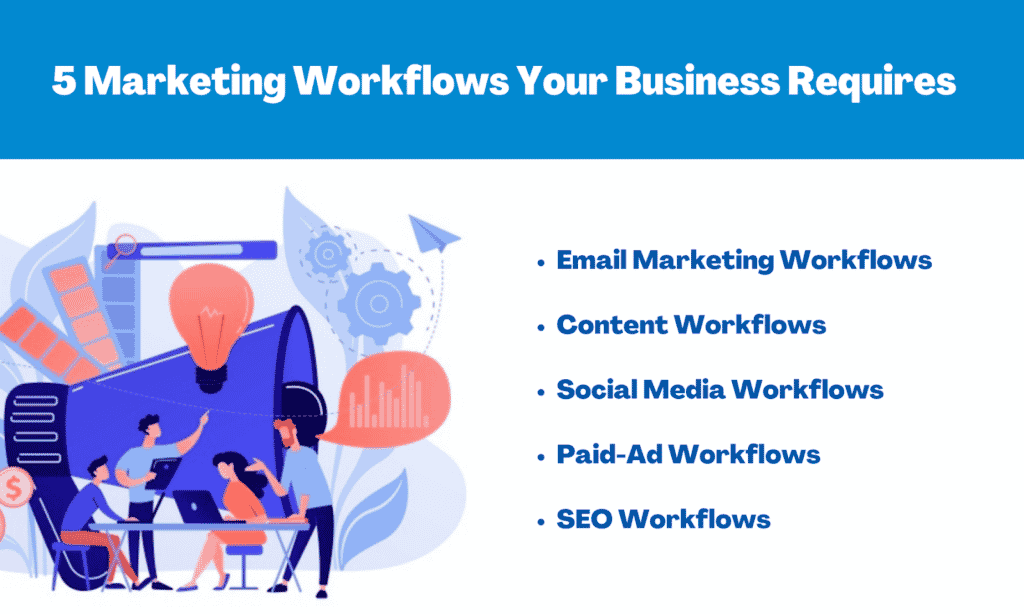
For those new to marketing, figuring out how to optimize and track marketing and workflow can be tricky. In marketing, generating leads for your business and making sure that you have a streamlined process that is efficient and functions by itself is vital. In the line of creating and making sure these processes are effective and smooth functions. You are required to optimize and track your marketing workflow as a whole.
But, where do you get started? Not to worry, in this article, we’ll walk you through everything you need to know about optimizing and tracking marketing workflow to ensure a smooth functioning and automated business process.
What Is Marketing Workflow?
Marketing Workflow is the general work process that takes place to ensure marketing takes place in an organization. Typically, this workflow is repetitive and follows a set pattern that, if done correctly, can be beneficial to all stakeholders.
Generally speaking, marketing tasks are divided into specific fields and these processes can be split up into various operations that take place with minimal need for micro-management. Marketing workflows comprise various activities centered around content, email marketing, paid ads, social media marketing, and other On-Page and Off-Page SEO practices.
In the course of business, these activities influence your business’s growth and revenue and in order to grow continually, you’ll need to continually optimize and track your progress. In doing this, you understand your business needs and requirements and include additional processes to help improve or get things back on track.
5 Marketing Workflows Your Business Requires for Smooth Functioning

Email Marketing Workflows
Getting leads through emails is a relatively straightforward process that’s been around for almost two decades. For businesses looking for an effective marketing process, making sure you have a sound email marketing workflow is essential.
To do this effectively, make sure you create an email marketing process that helps drive your sales funnel. With a set of clear objectives based on specific smart goals, you can ensure effective results with minimal time spent on tasks.
Steps to outline your email marketing process:
Step 1: Compile An Email Marketing List If Not Done Already
For users and marketers getting started from scratch, compiling an email marketing list based on your potential prospects from relevant sources is likely your first step.
One method to compile an effective email marketing list would be through a subscription form on your website. This way you can compile a list of relevant prospects for promoting future content and any other products you’re promoting.
Step 2: Fix Your Business Objective
From a business perspective, there can be several goals and objectives to accomplish. That said, it’s important that your focus is specifically on one option based on priority. For most businesses, engagement, conversion, and traffic are some of the most prominent objectives to pay attention to.
Step 3: Understand Your Prospects’ Needs
While you may have many business goals, understanding your prospects’ needs is a primary requirement. As a marketer, it’s paramount that you market your product where there is demand and need for it.
Step 4: Create Your Content
When it comes to creating content for the email market, your emailer is curated to convey, communicate your services and highlight the benefits of your product. Besides this, making sure that your product or service is pitched in the right way is vital before sending out your emailers.
Step 5: Measure the Responsiveness of Your Email Campaign
Finally, after the campaign is ongoing or completed it’s vital that you measure the success of the campaign through the number of conversions that take place. Other than this, you can also measure various other metrics like CTRs and overall traffic.
Content Workflows
For content workflows, it all comes down to delivering value through engaging and relevant content. While there may be several different routes you can take in your creative process, at the end of the day, your main objective is to create quality content. Besides this, you have an obligation to make it as simple and easy to understand for the readers.
In creating content, these are typically the steps that take place:
- Create a content calendar or topic repository with deadlines for delivery.
- Create your content and give it a quality check.
- Include rich media, like images and videos.
- In the case of the website content, ensure that your SEO is on point.
- Upload the content and give it an additional check.
- Publish your content on your content-relevant channels.
- Monitor the performance of your content.
Besides this, regular updates on your content and consistent research on new topics for your content calendar are general practices to follow. While the steps are quite simple, in the delivery process, limiting the iterations made and ensuring there is minimal time overspill is crucial.
Also read: Top 10 Tips to SEO Optimize Your Blog
Social Media Workflows
With social media workflows, the process while repetitive requires a little more receptiveness to your audience and an understanding of their preferences and habits. Creating content for social media can be time-intensive for campaigns without a clean-cut plan.
Generally, however, this is the typical format for social media workflow:
- Create content ideas based on relevance and current trends.
- Prepare various versions curated to the specific platforms to be shared on social media.
- Schedule a time for the post to be published (based on testing various times).
- Measure the engagement on the post.
- Engage with users that interact with the content.
Paid-Ad Workflows
As for paid ads, the metrics are quite insightful and you can curate them to specific target audiences based on target demographic. In general, paid ads are an effective way to engage with a large number of users to attract potential clients and consumers to your product or website. That said, for the most part, a lot of time is spent in research and in strategizing the most effective way to utilize your advertising budget.
Although there are several moving pieces, these are the typical Paid Ad workflows that most companies follow:
- Plan your budget, timeframe, template, and where you want the advertisement to run.
- Settle on your target demographic or audience for the ad campaign.
- Create your advertisement banner and ad copy keeping in mind your demographic and brand requirements.
- Launch your advertisement campaign.
- Measure and analyze the metrics for improvements when the ad campaign ends.
Also read: PPC for Small Businesses – Strategies
Search Engine Optimization Workflows
When it comes to search engine optimization, your workflow is relatively simple. That said, in SEO, there’s always an element of AB testing to see which methods are more effective. Keeping this aside, optimizing based on keywords is more or less the same for the most part.
With SEO workflows, these are the usual steps followed:
- Research and choose suitable keywords relevant to your site.
- Optimize your content based on reasonably competitive primary and secondary keywords for On-Page SEO.
- Get quality backlinks from sites (the links should have relevant content) to improve your Off-Page SEO.
- Measure the impact on the website.
Also read: SEO for Websites: How to Optimize Your Website for Search Engines
How Effective Marketing Workflows Impact Your Business
Marketing workflows play a crucial role in automating your business and in reducing the overall effort involved in day-to-day planning and tasks.
We’ve covered all the major workflows that impact your digital marketing avenues. Although there may be various other more complex factors at play, when it comes to day-to-day activity, most of the processes can be boiled down to the above repetitive tasks.
Although having a repetitive process may seem monotonous or daunting, if executed properly, it can be quite effective in the long run. Was this article helpful? Feel free to let us know in the comments.
Frequently Asked Questions
What is the most inexpensive form of marketing?
When it comes down to it, social media marketing provided it’s not paid, is the most affordable for time spent as well as the investment required. Social media can be done by anyone provided they have access to a laptop, and basic graphic design software, like Canva or Desygner.
What is Off-Page SEO?
Off-Page SEO is one aspect of SEO that relies entirely on backlinks from high authority sites with relevant content. The process of Off-Page SEO relies on acquiring backlinks through guest posts, PR, as well as a variety of other methods. While On-Page SEO ensures you rank for a keyword, Off-Page SEO helps Google understand that your site is trustworthy.


